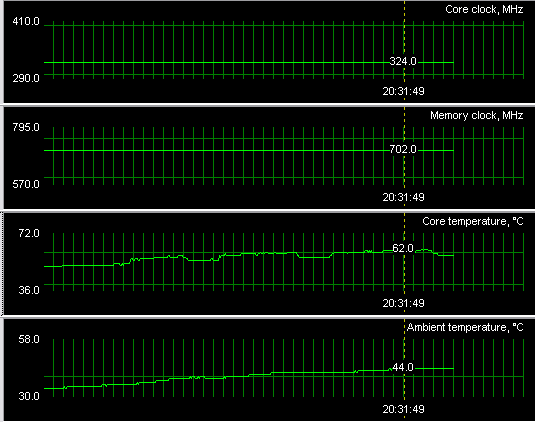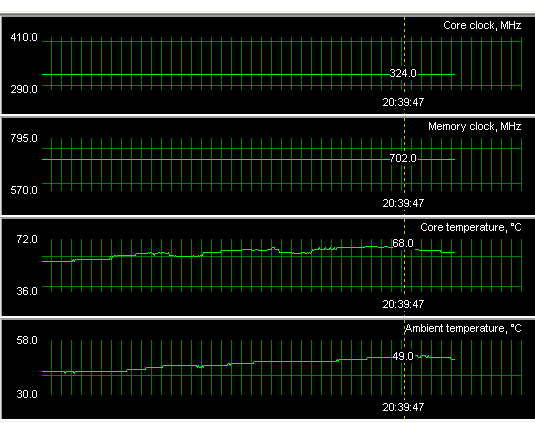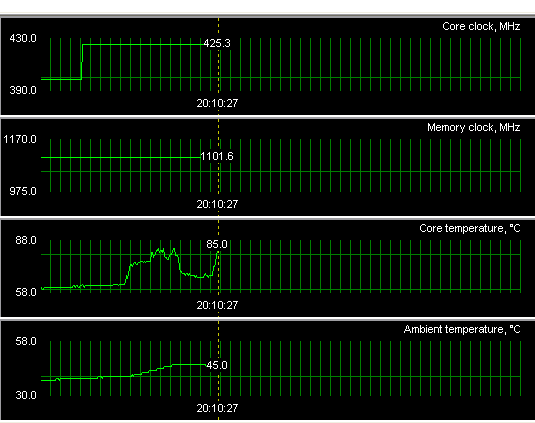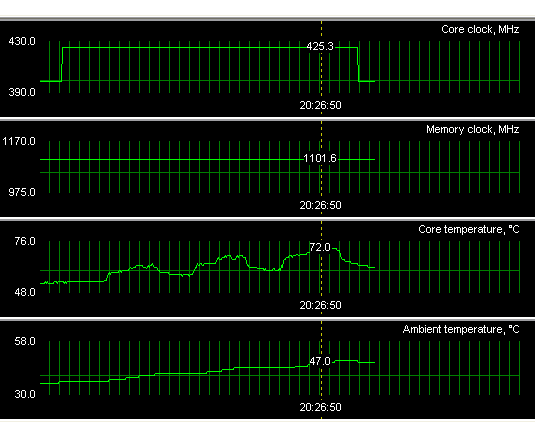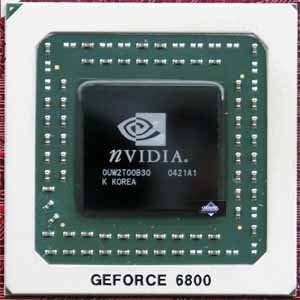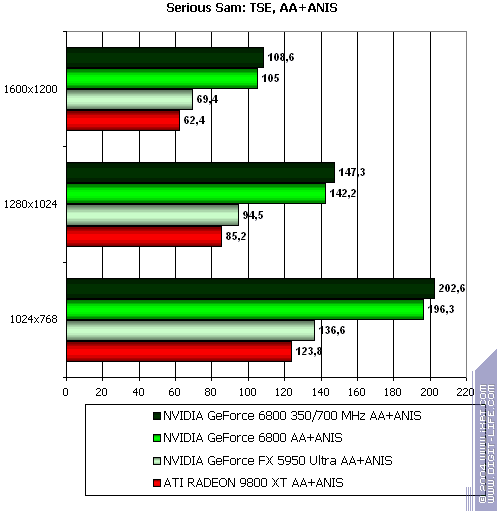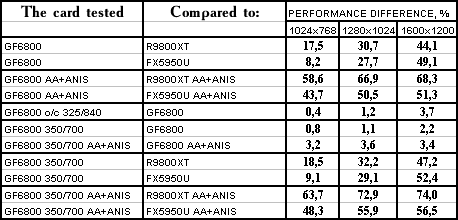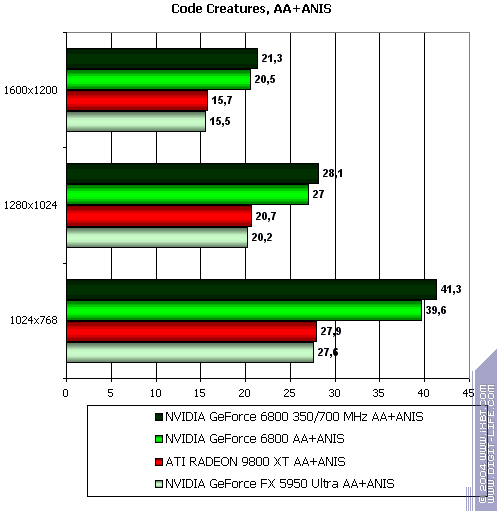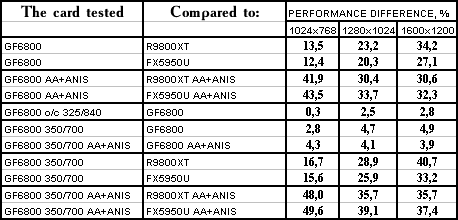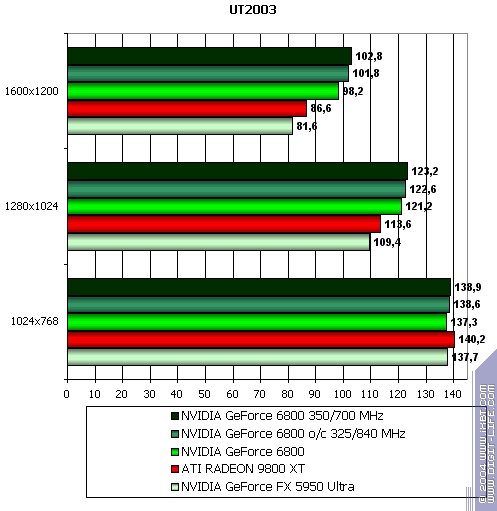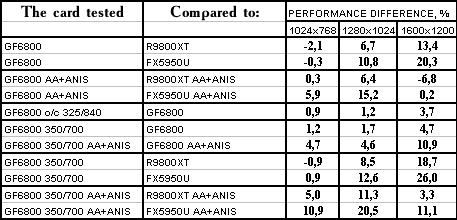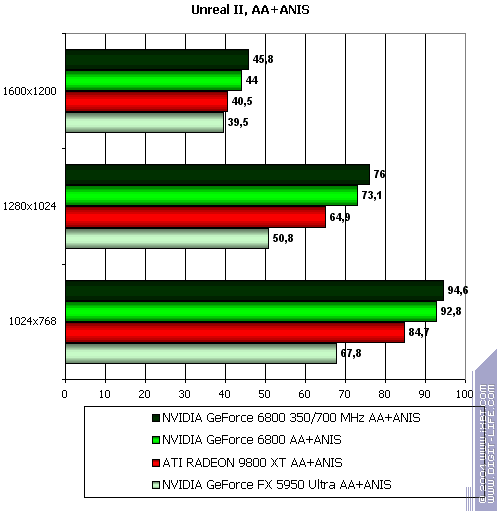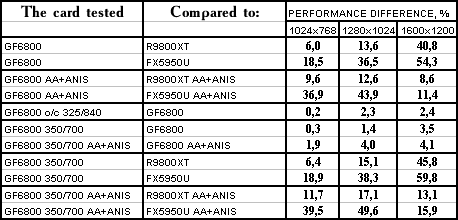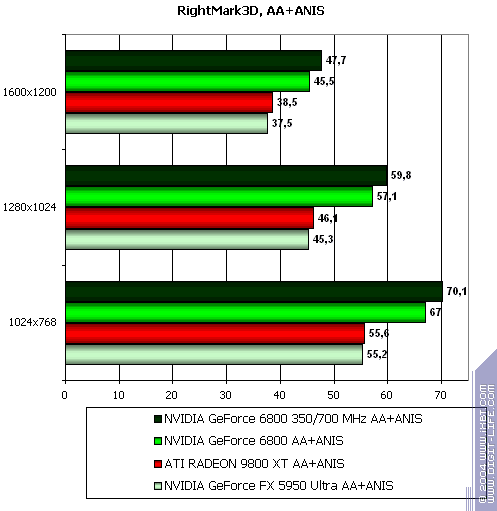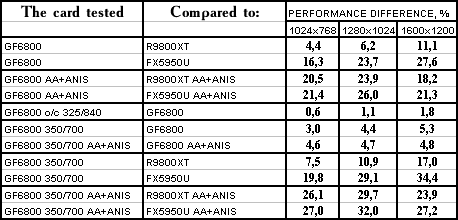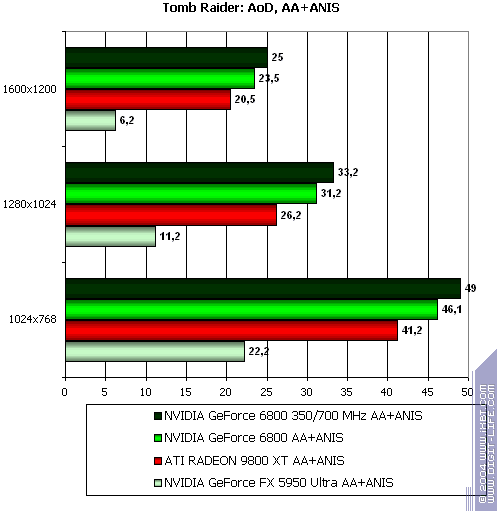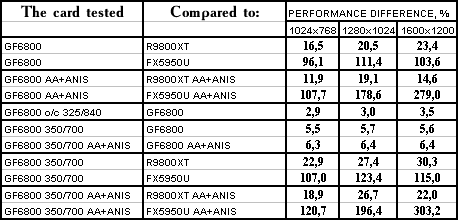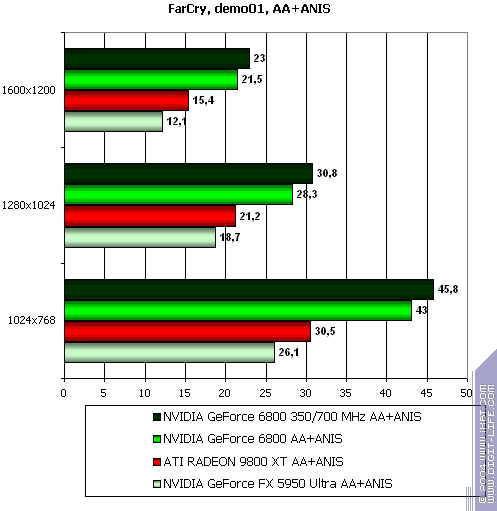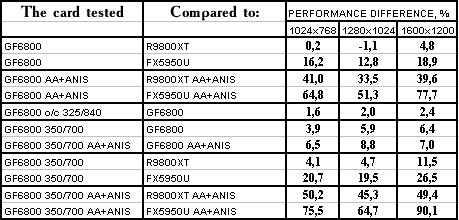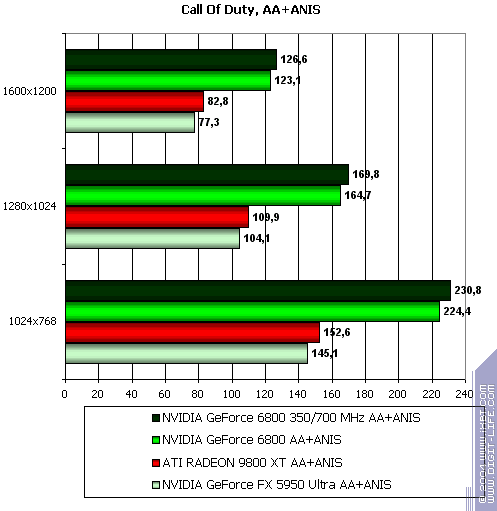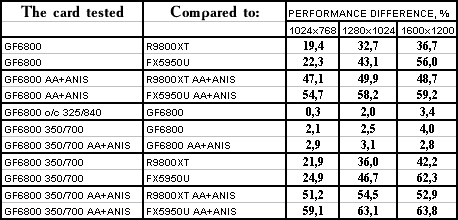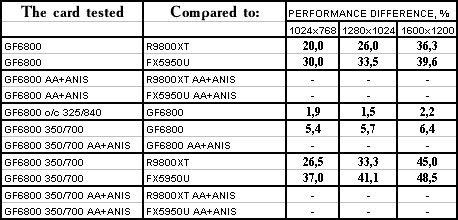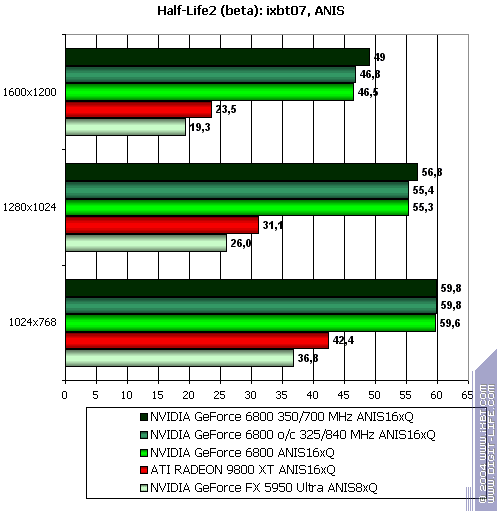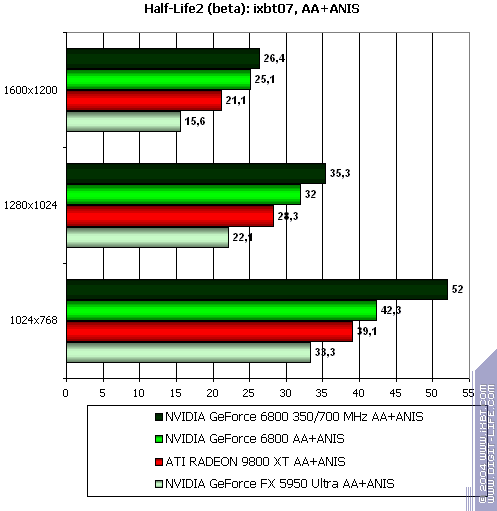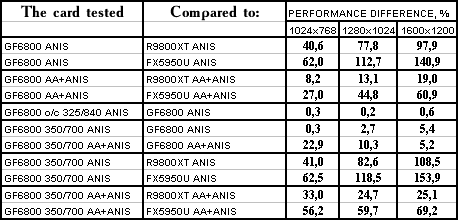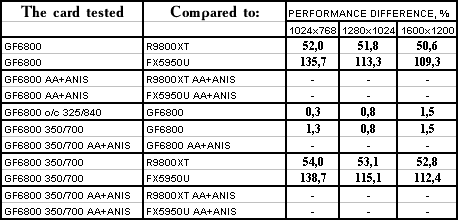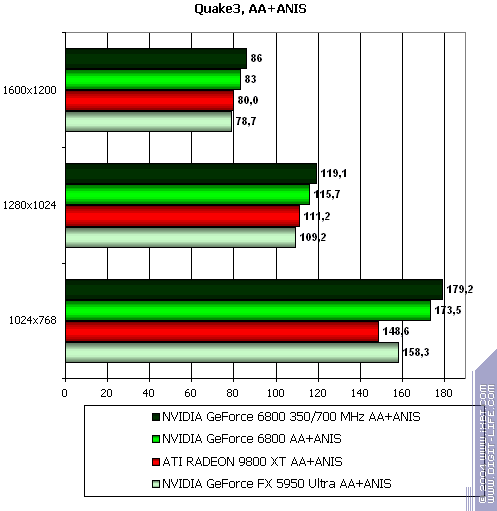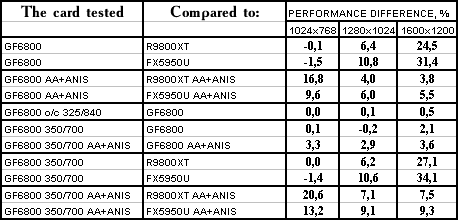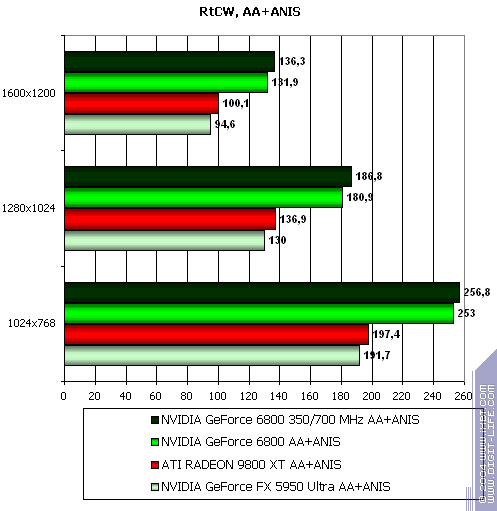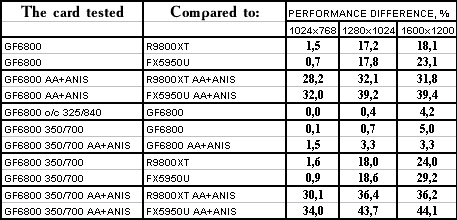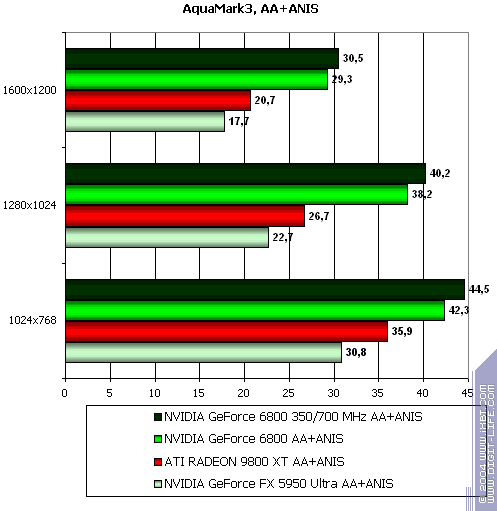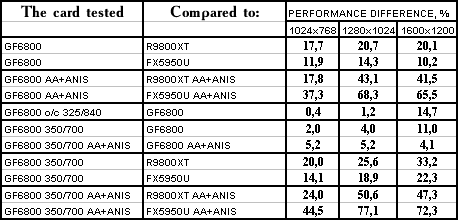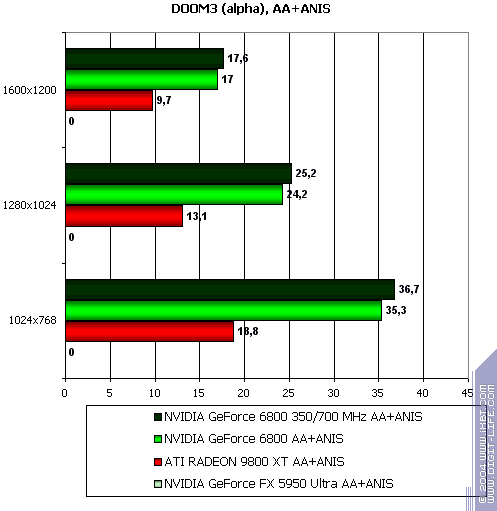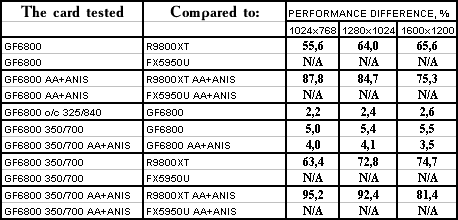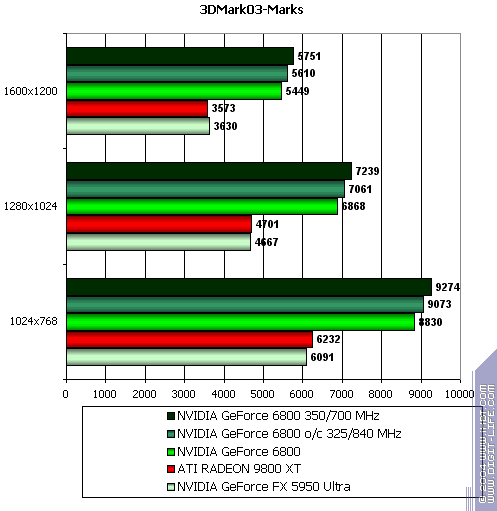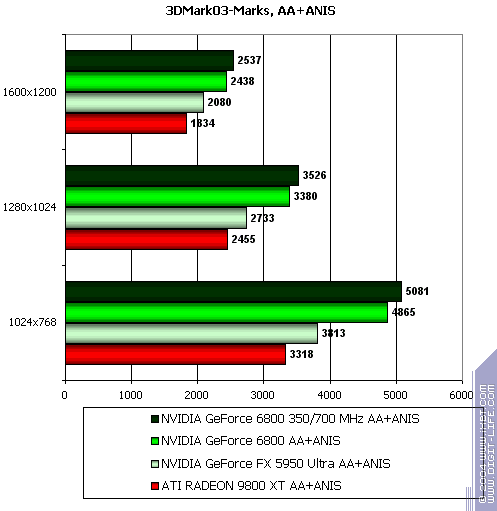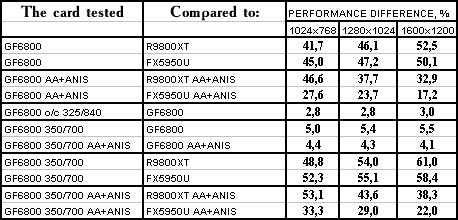MSI
NX6800-TD128,
Galaxy
Glacier GeForce 6800
based
on NVIDIA GeForce 6800
|
Contents
- Introduction
- Video
cards' features
- Testbed
configurations, benchmarks
- Test
results: Serious Sam: The Second Encounter
- Test
results: Code Creatures DEMO
- Test
results: Unreal Tournament 2003
- Test
results: Unreal II: The Awakening
- Test
results: RightMark 3D
- Test
results: TRAOD
- Test
results: FarCry
- Test
results: Call Of Duty
- Test
results: HALO: Combat Evolved
- Test
results: Half-Life2(beta)
- Test
results: Splinter Cell
- Test
results: Quake3 Arena
- Test
results: Return to Castle Wolfenstein
- Test
results: AquaMark3
- Test
results: DOOM3 (Alpha)
- Test
results: 3DMark03 (marks)
- Conclusions
We
proceed with our tests of video cards based on NVIDIA GeForce 6800, which are gradually
appearing on the market. It's a Low End model, which is intended to replace such
previous High End cards as RADEON 9800 XT and GeForce FX 5950 Ultra. ATI does not
yet have anything to offer in this segment, which could extrude RADEON 9800 XT from
the market (or could at least dramatically drop its prices, which is however hardly
possible because these cards are long out of production and stores offer the cards
that were purchased by the dealers long ago at high prices).
But
NVIDIA already has such products on sale at prices even lower than that of GeForce
FX 5950 Ultra or RADEON 9800 XT, which is very pleasing.
So,
what is 6800? It's a 12-pipeline chip dressed into narrow CPU bus bandwidth. Indeed,
you can see that the same memory operating not at 350 (700) MHz in GeForce FX5900
XT is installed on GeForce 6800. But for all that FX5900 XT has only 4 pipelines
and 8 texture units (compare with 12 pipelines and 12 texture units). The NV40 core
itself is not different from GeForce 6800 Ultra or GT in its features, it only has
fewer pipelines.
Theoretical
materials and reviews of video cards, which concern functional properties of the
GPU ATI
RADEON X800 (R420) and NVIDIA
GeForce 6800 (NV40)
So
in this material it'll be interesting to learn how strong the influence of CPU bus
bandwidth is on 6800 (in my tests I overclocked the memory on the card from 700 to
840 MHz, and I didn't touch the core). And due to the fact that the core of the Galaxy
card operates at 350 MHz instead of 325 MHz, we shall be able to learn how strong
the influence of GPU frequency raise is with the same CPU bus bandwidth (it's really
interesting how effective the memory resource saving technologies are with this relatively
low bandwidth).
Yes,
I have touched above the topic about the card from Galaxy. This company is almost
unknown in our country, though its products can be found on the shelves, but very
often as noname. Though you can see that it has even High-End products, with original
designs at that. The powerful cooling system allowed the specialists from this company
to increase the core frequency by 25 MHz to make their product deliberately a tad
faster than the other cards. Our tests will demonstrate exactly how faster it is.
I
think that there is no need in telling you about the MSI company, it's the oldest
brand in our market, its video cards have been known since 1998.
MSI
products stand out by the fact that MSI plant produces not only copies of reference
cards but cards of own design, especially it concerns cooling systems. You shouldn't
also forget that MSI offers almost the best bundle for its video cards we have ever
seen.
So,
in our laboratory we have tested two video cards based on GeForce 6800, which, according
to our research, is the best buy for those who have 350-370 USD for a powerful state-of-the-art
accelerator.
Video
Cards
| Galaxy Glacier GeForce 6800 |
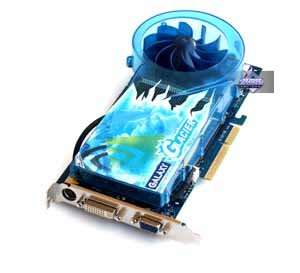
|
| MSI NX6800-TD128 |
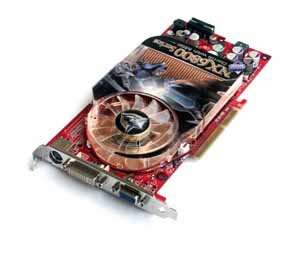
|
| Galaxy Glacier GeForce 6800 |
| The cards have an AGP x8/x4 interface, 128 MB
DDR SDRAM allocated in 8 chips on the front PCB side.
Hynix memory chips. 2.2ns memory access time, which corresponds
to 450 (900) MHz. The memory operates at 350 (700) MHz. GPU
frequency in MSI NX6800-TD128 is 325 MHz, and in Galaxy Glacier
GeForce 6800 the GPU frequency is 350 MHz. 256bit memory bus.
12 (3x4) pixel pipelines.
|
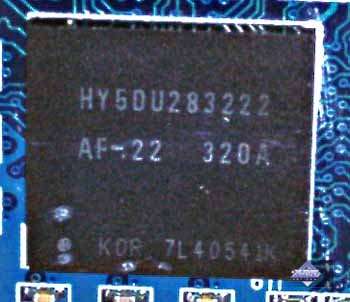
|
| MSI NX6800-TD128 |
| The cards have an AGP x8/x4 interface, 128 MB
DDR SDRAM allocated in 8 chips on the front PCB side.
Hynix memory chips. 2.8ns memory access time, which corresponds
to 350 (700) MHz, at which the memory operates. GPU frequency
in MSI NX6800-TD128 is 325 MHz, and in Galaxy Glacier GeForce
6800 the GPU frequency is 350 MHz. 256bit memory bus. 12 (3x4)
pixel pipelines.
Later we found out that this video card actually
has 16 pipelines (4x4) instead of 12. We don't know what was
the reason for such chip in GeForce 6800 and whether all such
cards will be equipped with a 16-pipeline GPU.
|
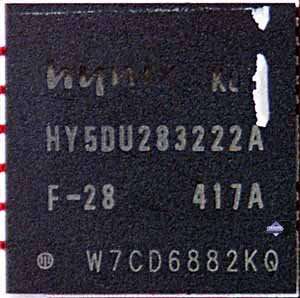
|
| Comparison with the reference design,
front view |
|
Galaxy Glacier GeForce 6800
|
Reference card NVIDIA GeForce 6800
|
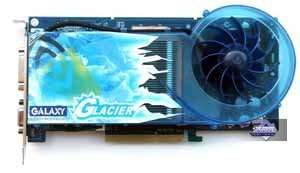
|
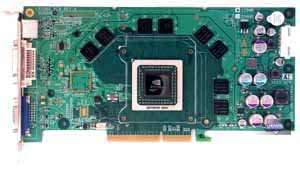
|
|
MSI NX6800-TD128
|
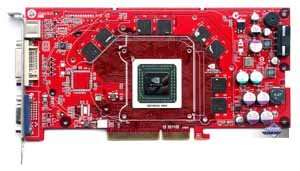
|
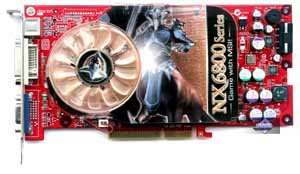
|
| Comparison with the reference design,
back view |
|
Galaxy Glacier GeForce 6800
|
Reference card NVIDIA GeForce 6800
|
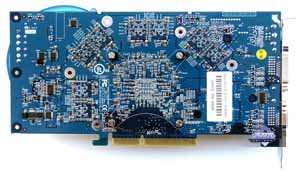
|
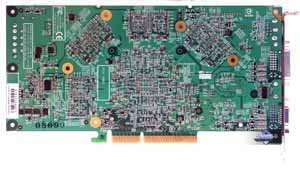
|
|
MSI NX6800-TD128
|
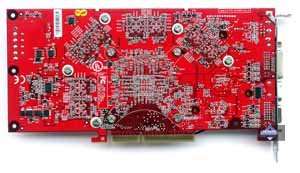
|
Both
cards are obviously of the same design based on the reference one. In fact the PCBs
differ only in lacquer colors. The layout of memory chips is similar to GeForce FX
5900, actually they have a similar design. The only external power connector is located
in the upper part of the card. A 300Wt power supply unit will be sufficient for the
card's operation in an average system block. I want to note that the memory in the
video card from Galaxy offers great overclocking potential and thus overclockers
are sure to like this card.
But
the cooling systems in these cards are different.
| MSI NX6800-TD128 |
|
Look at the very effective system from ARX (well-known cooler
manufacturer) based on a narrow copper heatsink sprawled on
the PCB.
The heatsink is narrow enough for the cooler not to cover
the slot next to AGP. A powerful fan is on the left, it can
operate at 5000 rpm, but this revolution frequency is either
enabled by the driver in case of graphic processor overheating,
or it is specified by a slider on top of the heatsink.
The cooler is similar to those we have previously seen in
ATI RADEON 9800 XT (X800) - see the bottom photo on the right.
At least it has the same operating principle.
|
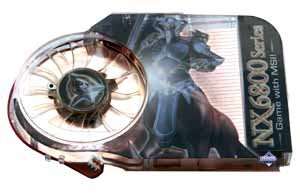
|
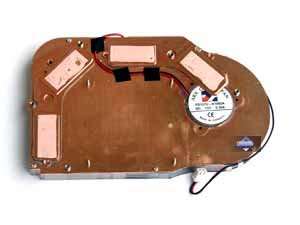
|

|
| Galaxy Glacier GeForce 6800 |
|
The video card from Galaxy possesses a cooling system from
Arctic Cooling. We have already come across the same system
in HIS video cards based on RADEON X800.
Galaxy Glacier GeForce 6800 just has a different plastic color
(blue instead of colorless/transparent). It's a very effective
cooling system, which, despite its high rpms, has a silent fan-turbine
blowing out the air from the system block, unlike the previous
one. It goes without saying that the card blocks the slot next
to AGP because of its huge size.
|
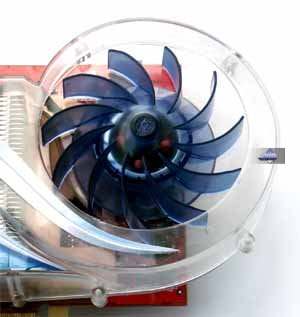
|

|
Let's
return to the cooler installed on the card from MSI. Looking at this strikingly effective
cooling system, which occupies only one slot, we decided to check (1) what will happen
to the temperature condition if we set the fan rpm slider to minimum; (2) how this
cooler will operate in GeForce 6800 Ultra, considering that the PCB mounting holes
are identical.
The
device is firmly attached to the card with 8 screws (4 screws at chip corners, and
4 screws between memory chips).
Thus,
with maximum fan rpms in GeForce 6800 we got the following temperature curve (we
used RivaTuner to take temperature readings (written by Alexei Nikolaichuk AKA Unwinder)):
We
can see that the maximum temperature (in 3D, FarCry) was 62 degrees centigrade at
GPU. This is very good and there is much in reserve. And now let's set the slider
to minimum:
The
temperature rose to 68 degrees centigrade. This also has much in reserve so we can
fearlessly recommend the minimum position of the slider, in this case you will not
hear the fan at all.
Now
let's install this cooling system to 6800 Ultra (slider to High, that is to maximum
rpm):
You
can see the temperature quickly rise to critical 85 degrees, and... the card froze
(you can see the break in readings).
Alas,
the design of this cooler does not really fit 6800 Ultra, it's obviously not sufficient.
Perhaps we should have increased rpm, but this cooler can hardly handle it. Besides,
for a sufficient cooling effect 6800 Ultra needs separate heatsinks for the memory
and the chip. Why? - It's very simple: a slightest misfit of the heatsink for the
chip heights will result in a microgap between the chip and the heatsink. In 6800
this gap can be compensated by the thermopaste viscosity, but in 6800 Ultra it cannot
be compensated.
Below
is a temperature curve for 6800 Ultra with an original cooler:
Yes,
the temperature here does not rise above 72 degrees. It should be specially noted
that all the experiments were conducted inside the case with disabled case fans.
You
can see the chip under the coolers. It has an FCPGA package, the crystal size is
impressive (we have already talked about it before). It's clear that it physically
contains 16 (not 12) pipelines, 4 of them are disabled (to think logically the crystals
are sorted by their nonoperability; but they may be sorted that way by marketing
reasons, we are still looking for an option to enable these pipelines in a smooth
software way)
Let's
examine the package contents.
| MSI NX6800-TD128 |
| The box contains a user's guide, a lot
of CDs (14 items!) with various software (see the photo on the
right), TV extension cords, DVI-to-d-Sub, SVideo-to-RCA adapters,
external power supply splitter. The bundle is fit for a king!
|

|
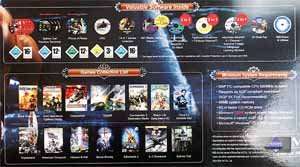
|
| Galaxy Glacier GeForce 6800 |
| The box contains a user's guide, CD with drivers,
3 CDs with games (Chaser, MotoGP, game demos), PowerDVD, TV extension
cords, DVI-to-d-Sub, SVideo-to-RCA adapters, power supply cable.
Note that the bundle contains two modern games: Prince of Persia
and SCPT (the latter is on DVD!), which is a good thing. |
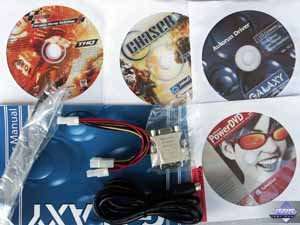
|
And
now look at the boxes:
Now
about overclocking the video card from MSI. The tests conducted are quite enough,
the memory was overclocked to 840 MHz. I didn't specially overclock the core (in
fact, I'm not up to overclocking, this data is provided only as a reference, because
you cannot draw conclusions from the overclocking potential of a SPECIFIC card sample).
Concerning
the video card from Galaxy, its memory managed to operate even at 500 (1000) MHz!
This is possible obviously due to 2.2ns memory chips. So I repeat, this video card
is a real boon for overclockers.
Installation
and Drivers
Testbed
configurations:
- Athlon
64 3200+ based computer
- AMD
Athlon 64 3200+ (L2=1024K) CPU
-
ASUS
K8V SE Deluxe mainboard
on VIA K8T800
- 1
GB DDR SDRAM PC3200
- Seagate
Barracuda 7200.7 80GB SATA HDD
- Operating
system: Windows XP SP1; DirectX 9.0b
- Monitors: ViewSonic
P810 (21")
and Mitsubishi
Diamond Pro 2070sb (21")
- ATI
drivers v6.458 (CATALYST 4.7); NVIDIA v61.76
VSync
is disabled.
Test
results: performance comparison
We
used the following test applications:
- Serious
Sam: The Second Encounter v.1.05 (Croteam/GodGames) - OpenGL, multitexturing, ixbt0703-demo,
test settings: quality, S3TC
OFF
- Unreal
Tournament 2003 v.2225 (Digital Extreme/Epic Games) - Direct3D, Vertex Shaders, Hardware
T&L, Dot3, cube texturing, default quality
- Code
Creatures Benchmark Pro (CodeCult) - game test demonstrating how the card operates
with DirectX 8.1, Shaders, HW T&L.
- Unreal
II: The Awakening (Legend Ent./Epic Games) - Direct3D, Vertex Shaders, Hardware T&L,
Dot3, cube texturing, default quality
- RightMark
3D v.0.4 (one
of the game scenes) - DirectX 8.1, Dot3, cube texturing, shadow buffers, vertex and
pixel shaders (1.1, 1.4).
- Tomb
Raider: Angel of Darkness v.49 (Core Design/Eldos Software) - DirectX 9.0, Paris5_4
demo. Maximum quality, we only disabled Depth of Fields PS20.
- HALO:
Combat Evolved (Microsoft) - Direct3D, Vertex/Pixel Shaders 1.1/2.0, Hardware T&L,
maximum quality
- Half-Life2
(Valve/Sierra) - DirectX 9.0, demo (ixbt07.
Tested with anisotropic filtering disabled, and also in a heavy mode with AA and
anisotropy.
- Tom
Clancy's Splinter Cell v.1.2b (UbiSoft) - Direct3D, Vertex/Pixel Shaders 1.1/2.0,
Hardware T&L, maximum quality (Very High); demo 1_1_2_Tbilisi
- Call
of Duty (MultiPlayer) (Infinity Ward/Activision) - OpenGL, multitexturing, ixbt0104demo,
the test settings - Very High, S3TC
ON
- FarCry
1.1 (Crytek/UbiSoft), DirectX 9.0, multitexturing, demo01 (research) (the game is
started with the key -DEVMODE), the test settings - Very High.
- 3DMark03
v.3.40 (FutureMark) - DirectX 9.0, multitexturing, maximum possible test settings.
- AquaMark3
(Massive Development) - DirectX 9.0, multitexturing, maximum possible test settings.
- Quake3
Arena v.1.17 (id Software/Activision) - OpenGL, multitexturing, ixbt0703-demo, maximum
possible test settings: detailing
- High,
texture details
- T70;4, S3TC
OFFcurved
surfaces are smoothed by the variables r_subdivisions
"1" and r_lodCurveError
"30000" (note
that the default value of r_lodCurveError is "250"!)
- Return
to Castle Wolfenstein (MultiPlayer) (id Software/Activision) - OpenGL, multitexturing,
ixbt0703-demo, maximum possible test settings, S3TC
OFF
- DOOM
III (alpha version) (id Software/Activision) - OpenGL, multitexturing, maximum possible
test settings, S3TC
OFF
If
you want to get the demo-benchmarks, which we use, contact me at my e-mail.
ANIS
mode on the diagrams means Anisotropic 16x Quality (FX5950 - 8x Quality), AA - Anti-Aliasing
4x Quality
I
want to note that the diagrams below display the data obtained with "regular"
GeForce 6800 (12 pipelines).
Serious
Sam: The Second Encounter
Thus,
on the whole:
- NVIDIA
GeForce 6800 versus ATI RADEON 9800 XT - up to 66% advantage!
- NVIDIA
GeForce 6800 versus NVIDIA GeForce FX 5950 Ultra - up to 51% advantage
- NVIDIA
GeForce 6800 with memory overclocked to 840 MHz - the effect is insignificant, up
to 3.7%, which is within the allowed precision of measurements. Interestingly, this
game requires much RAM. Yet HSR operates well in 6800.
- NVIDIA
GeForce 6800 with the core overclocked to 350 MHz - there is almost no gain even
at heavy load. Comparing this with the previous effect, there is some contradiction.
Perhaps even with a heavy load it all depends on system resources and the effect
of the video card performance gain is minimal.
Code
Creatures
Thus,
on the whole:
- NVIDIA
GeForce 6800 versus ATI RADEON 9800 XT - 34% advantage
- NVIDIA
GeForce 6800 versus NVIDIA GeForce FX 5950 Ultra - much the same, the advantage is
up to 44%
- NVIDIA
GeForce 6800 with its memory overclocked to 840 MHz - similar to the previous test,
CPU bus bandwidth expansion gave nothing, though in this case a larger part of load
is on the core.
- NVIDIA
GeForce 6800 with its core overclocked to 350 MHz - confirms the above, the effect
is almost twice as great, though percentage wise the core was overclocked less than
the memory.
Unreal
Tournament 2003
The
easiest modes without AA and anisotropy: on the whole 6800 is the leader, if not
to take into account the parity in 1024x768. But here the game is up to system resources,
everything depends on software, not hardware.
The
final heaviest mode with AA and anisotropy: very much the same. The only discord
is a performance drop of 6800 in 1600x1200.
Thus,
on the whole:
- NVIDIA
GeForce 6800 versus ATI RADEON 9800 XT - overall victory, but in heavy modes there
are parity situations
- NVIDIA
GeForce 6800 versus NVIDIA GeForce FX 5950 Ultra - earnest victory with the score
up to 20%
- NVIDIA
GeForce 6800 with its memory overclocked to 840 MHz - there is still no effect (HSR
"rules")
- NVIDIA
GeForce 6800 with its core overclocked to 350 MHz - the gain is more considerable,
but still insignificant in light modes, and much more considerable with AA and AF
(which again testifies that the game depends on CPU etc).
Unreal
II: The Awakening
Thus,
on the whole:
- NVIDIA
GeForce 6800 versus ATI RADEON 9800 XT - victory, 6800 outscores with 12-40% depending
on the resolution
- NVIDIA
GeForce 6800 versus NVIDIA GeForce FX 5950 Ultra - the same results, but the advantage
reaches 54%
- NVIDIA
GeForce 6800 with its memory overclocked to 840 MHz - no effect
- NVIDIA
GeForce 6800 with its core overclocked to 350 MHz - minimal effect.
RightMark
3D
Thus,
on the whole:
- NVIDIA
GeForce 6800 versus ATI RADEON 9800 XT - 6800 is the champion, its advantage increasing
simultaneously with the load
- NVIDIA
GeForce 6800 versus NVIDIA GeForce FX 5950 Ultra - also victory, the advantage is
up to 27%
- NVIDIA
GeForce 6800 with its memory overclocked to 840 MHz - null effect (it's quite clear,
the core is loaded)
- NVIDIA
GeForce 6800 with its core overclocked to 350 MHz - there is little gain, which is
quite logical.
TR:AoD,
Paris5_4 DEMO
Thus,
on the whole:
- NVIDIA
GeForce 6800 versus ATI RADEON 9800 XT - not a bad gain of 12-23%
- NVIDIA
GeForce 6800 versus NVIDIA GeForce FX 5950 Ultra - phenomenal performance gain. It's
all up to shaders. And we all know how slow they were in the GeForce FX series.
- NVIDIA
GeForce 6800 with its memory overclocked to 840 MHz - minimal effect
- NVIDIA
GeForce 6800 with its core overclocked to 350 MHz - the gain is a little more considerable,
but still the low CPU bus bandwidth is the bottleneck.
FarCry,
demo01
The
easiest modes without AA and anisotropy: small gain.
The
heaviest final mode with AA and anisotropy: these modes result in performance gain
leap.
Thus,
on the whole:
- NVIDIA
GeForce 6800 versus ATI RADEON 9800 XT - from almost parity without AA+AF (it was
all up to the system resources) to 41% performance gain in 6800!
- NVIDIA
GeForce 6800 versus NVIDIA GeForce FX 5950 Ultra - a holiday for 6800: huge advantage!
- NVIDIA
GeForce 6800 with its memory overclocked to 840 MHz - almost no effect
- NVIDIA
GeForce 6800 with its core overclocked to 350 MHz - the game loads the core heavily,
that's why its core overclocking results in more gain.
Call
of Duty, ixbt04
Thus,
on the whole:
- NVIDIA
GeForce 6800 versus ATI RADEON 9800 XT - victory! With the score of 50%!
- NVIDIA
GeForce 6800 versus NVIDIA GeForce FX 5950 Ultra - the same results, but the advantage
already reaches 60% (just imagine the game running 60% faster!)
- NVIDIA
GeForce 6800 with its memory overclocked to 840 MHz - almost no effect
- NVIDIA
GeForce 6800 with its core overclocked to 350 MHz - the same results.
HALO:
Combat Evolved
Thus,
on the whole:
- NVIDIA
GeForce 6800 versus ATI RADEON 9800 XT - 20-36% advantage
- NVIDIA
GeForce 6800 versus NVIDIA GeForce FX 5950 Ultra - the same results, but the figures
reach 30-40%
- NVIDIA
GeForce 6800 with its memory overclocked to 840 MHz - no effect
- NVIDIA
GeForce 6800 with its core overclocked to 350 MHz - there is little gain, the game
mostly depends on the core potential.
Half-Life2
(beta): ixbt07 demo, ANISO 16xQ
Thus,
on the whole:
- NVIDIA
GeForce 6800 versus ATI RADEON 9800 XT - it's interesting to see the reverse picture.
No, 6800 has not lost! But as a rule the gain is higher with AA+AF in comparison
with easy modes, but here everything is vice versa. That's very strange, it's most
likely the drivers' fault, they must have overloaded the card in heavy modes.
- NVIDIA
GeForce 6800 versus NVIDIA GeForce FX 5950 Ultra - almost the same picture.
- NVIDIA
GeForce 6800 with its memory overclocked to 840 MHz - nothing new
- NVIDIA
GeForce 6800 with its core overclocked to 350 MHz - there is some gain, which is
characteristic of this game.
Splinter
Cell
Thus,
on the whole:
- NVIDIA
GeForce 6800 versus ATI RADEON 9800 XT - huge gain!
- NVIDIA
GeForce 6800 versus NVIDIA GeForce FX 5950 Ultra - the huge becomes giant!
- NVIDIA
GeForce 6800 with its memory overclocked to 840 MHz - nothing!
- NVIDIA
GeForce 6800 with its core overclocked to 350 MHz - much the same, it's up to the
system resources.
Quake3
Arena
Thus,
on the whole:
- NVIDIA
GeForce 6800 versus ATI RADEON 9800 XT - some quivering of performance gain depending
on the resolution (actually this game has always depended on system resources in
powerful video cards)
- NVIDIA
GeForce 6800 versus NVIDIA GeForce FX 5950 Ultra - victory, but somehow very strange,
the driver is fooling around again.
- NVIDIA
GeForce 6800 with its memory overclocked to 840 MHz - zero
- NVIDIA
GeForce 6800 with its core overclocked to 350 MHz - almost nothing.
Return
to Castle Wolfenstein (Multiplayer)
Thus,
on the whole:
- NVIDIA
GeForce 6800 versus ATI RADEON 9800 XT - victory with 17-32%
- NVIDIA
GeForce 6800 versus NVIDIA GeForce FX 5950 Ultra - the same results
- NVIDIA
GeForce 6800 with its memory overclocked to 840 MHz - a little gain in 1600x1200
- NVIDIA
GeForce 6800 with its core overclocked to 350 MHz - the same results
AquaMark3
Thus,
on the whole:
- NVIDIA
GeForce 6800 versus ATI RADEON 9800 XT - confident victory with 18-41%
- NVIDIA
GeForce 6800 versus NVIDIA GeForce FX 5950 Ultra - the same results, the advantage
is over 65%
- NVIDIA
GeForce 6800 with its memory overclocked to 840 MHz - we can see that for the first
time the CPU bus bandwidth expansion produced positive results, 14% gain (obviously
in the highest resolution). I would have never thought that this test (strongly overloading
the core) would depend on the memory clock.
- NVIDIA
GeForce 6800 with its core overclocked to 350 MHz - the effect is even lower than
the previous one.
DOOM
III (alpha)
Unfortunately,
this test couldn't be run on FX 5950 (driver), so we shall compare only with 9800
XT.
Thus,
on the whole:
- NVIDIA
GeForce 6800 versus ATI RADEON 9800 XT - excellent results, 88% gain!
- NVIDIA
GeForce 6800 with its memory overclocked to 840 MHz - almost no effect
- NVIDIA
GeForce 6800 with its core overclocked to 350 MHz - little gain
3DMark03
- MARKS
Thus,
on the whole:
- NVIDIA
GeForce 6800 versus ATI RADEON 9800 XT - the usual victory with 50%
- NVIDIA
GeForce 6800 versus NVIDIA GeForce FX 5950 Ultra - the same results
- NVIDIA
GeForce 6800 with its memory overclocked to 840 MHz - almost no effect
- NVIDIA
GeForce 6800 with its core overclocked to 350 MHz - there is some gain, but...
Conclusions
First
of all I want to note that strangely enough with its 12 pipelines and the core clock
at 325 MHz (3900 billion texels/sec) GeForce 6800 is quite a balanced video card
with CPU bus bandwidth implemented via memory at 350 (700) MHz. Considering that
the fill rate of RADEON 9800 XT is 3300 billion texels/sec, plus its combination
with 730 MHz memory clock and decent performance gain over 9800 XT (up to 50-60%),
the effectiveness of GeForce 6800 speaks for itself. Every single MHz of this chip
is much more effective despite the practically identical CPU bus bandwidth in 9800
XT.
Our
tests proved that the card does not really need the raise in memory clock, which
allows NVIDIA and its partners to considerably reduce the net cost of these cards
in comparison with GeForce 6800 GT (high-performance GDDR3 is very expensive now
and constitutes a great part of the net cost of video cards).
Now
about the cards. Galaxy Glacier GeForce 6800 is the first.
As
you can see from the test results, a frequency raise by 25 MHz produces little effect,
but it's still pleasant and you can get moral satisfaction from it :). But I repeat
that this card is equipped with 2.2ns memory instead of the standard (in such cases)
2.8ns memory, that's why it can be considerably overclocked. However, as we have
previously seen, this will not have a brilliant effect.
The
cards look wonderful as well as their operation. Besides, the Arctic Cooling cooler
is almost noiseless, and overheating is not an option with 6800. What concerns the
2D quality, our sample was quite all right, it was comfortable to work in 1600x1200
at 85Hz.
MSI
NX6800-TD128.
This
video card has a nice design, the cooler perfectly matches the red PCB. It can also
be made almost noiseless, our research proved that the heat dissipation will not
deteriorate.
Astounding
package contents makes this video card a cherished purchase for those who have 350-370
USD for a state-of-the-art 3D-accelerator (the retail price for early august in Moscow).
I
note once again that this sample is equipped with 16 pipelines instead of 12.
Both
cards are stable, there are no reprimands, the quality is good.
In our 3DiGest you can find more detailed
comparisons of various video cards.
According
to the test results MSI NX6800-TD128 merits the Excellent Package award (July).
This
card (MSI NX6800-TD128) also merits the Original Design Award (July).
Write a comment below. No registration needed!
|
|
 |
|
|
|

